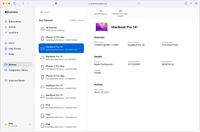
2024: Kandji's Year in Review
In 2024, Kandji continued to revolutionize Apple device management with groundbreaking innovations, powerful new integrations, and significant improvements to our core platform.
Keep reading
Table of Contents
Apple Business Manager is a free service provided by Apple that enables organizations to gain control over their fleet of Apple devices. Apple Business Manager helps with everything from managing purchases to securing endpoints and rolling out software updates.
Apple Business Manager is a service that enables organizations to procure and deploy Apple devices and software. It also forms the foundation for using Apple mobile device management (MDM) with your Apple devices. When coupled with an Apple MDM server, Apple Business Manager empowers IT administrators to purchase, configure, deploy, and secure macOS, iOS, iPadOS, and tvOS devices.

After an organization completes the necessary legal agreements, Apple Business Manager can keep a list of every Apple device an organization purchases from Apple itself or an authorized reseller. That establishes that (a) the organization purchased the device and (b) that it’s appropriate for the organization to use the power of MDM to manage the device.
In fact, every new macOS, iOS, iPadOS, and tvOS device will try to connect to Apple Business Manager out of the box, to check whether it should be managed by an organization. If it should be, the device will automatically enroll itself in the organization’s MDM server, which can then push out device configurations, security controls, and software updates to Mac, iPhone, iPad, and Apple TV.
Together, Apple Business Manager and an Apple MDM server enable onboarding via zero-touch deployment. That means admins can set up and ship devices directly to end-users, which will then automatically be loaded with the organization’s standard set of applications and a user-driven device setup routine, without ever physically touching those devices.
See Kandji in Action
Experience Apple device management and security that actually gives you back your time.
Apple Business Manager inherits the functionality of the Apple Device Enrollment Program (DEP) and the Apple Volume Purchase Program (VPP), both of which were discontinued at the end of 2019. Apple Business Manager is what makes the replacements for DEP and VPP—Automated Device Enrollment and Apps & Books, respectively—possible.
By itself, Apple Business Manager offers limited functionality, much of it intended to streamline the purchasing and provisioning of Apple hardware and software for business customers. But coupled with an MDM solution, it enables admins to manage Apple devices at scale.
To get started with Apple Business Manager, an IT admin fills out a web form with the organization’s details. Those details include the organization’s Apple Customer Number and/or an Apple Reseller ID, depending on whether an organization purchased Apple devices from Apple directly or from one of its partners (or both). One important detail in the web form is the contact information for a person at the organization who has the legal authority to agree to terms and conditions on behalf of the organization. This person must be available for a phone call from an Apple agent to verify certain details. The signup cannot move forward until that conversation happens.
Once that signup is verified and approved by Apple, the next step is to identify those in the organization who should have Apple Business Manager administration privileges.
That done, those administrators can link Apple Business Manager to one or more Apple MDM servers, by entering the server name and authorization information and uploading a token generated by Apple Business Manager to the MDM server.
This enables Automated Device Enrollment, which automatically transfers the details of all devices purchased from Apple or authorized resellers to the MDM server. (Admins can enroll devices purchased prior to enrollment in Apple Business Manager if the organization (a) purchased the devices using its Apple Customer Number, (b) purchased the devices from a supported reseller, or (c) used Apple Configurator.)
Apple Business Manager is also where you create Managed Apple IDs. These are similar to personal Apple IDs, providing users access to whichever Apple apps and services they’re authorized to use. The main difference is that Managed Apple IDs are owned and managed by an organization rather than by users.
But no one wants yet another user directory to manage. That’s why Apple Business Manager offers directory federation. When an admin federates the organization’s Apple Business Manager account with its instance of either Microsoft Azure Active Directory or Google Workspace, that will automatically create a Managed Apple ID for each user in Azure or Google Workspace, and import the user authentication details stored in those directory services. Such Managed Apple IDs can even be used on devices added via user enrollment.
However, regardless of whether or not you’re ready to federate, you can always use Apple Business Manager to create Managed Apple IDs manually.
Managed Apple IDs can associate users with company-authorized devices and provide access to a subset of Apple services, such as iCloud Drive. Managed Apple IDs can not be used to access services that are not work-related, such as Apple Pay or Apple Arcade. Managed Apple IDs assigned an administrator role allow those who possess them to edit users’ Managed Apple IDs, unlock user accounts, reset passwords, and more.
Apple Business Manager gives admins the means to obtain App Store licenses, which is the first step in procuring apps and books (which collectively Apple refers to as “content”) for an organization and distributing them to employees. This process involves downloading one or more content tokens using Apple Business Manager and passing them to the Apple MDM server.
Apple MDM solutions enable admins to establish groups of devices, with each group assigned its own standard content mix. The ease with which admins can create and edit these groups and dynamically move devices among them is a key factor in evaluating an Apple MDM solution. Easy, automated distribution of updates of apps from the server is another work-saving feature.
Features such as Automated Device Enrollment are simply not available without Apple Business Manager as a foundation. But small businesses can opt for the paid Apple Business Essentials subscription service, which offers all the functionality of Apple Business Manager plus iCloud storage and AppleCare+ (the latter includes 24/7 phone support, onsite repairs, and specialized training). Apple Business Essentials comes with a handful of MDM features, but for all but the smallest organizations, an Apple MDM server remains essential.
Educational institutions will use Apple School Manager instead of Apple Business Manager. Apple School Manager incorporates the features of Apple Business Manager, but adds support for student information systems, classes as a form of user group, roles for teachers and students, more iCloud Drive space for student work, and more. Like Apple Business Manager, Apple School Manager is free of charge.
Most organizations, however, will choose Apple Business Manager as the first step in gaining control over their fleet of Apple devices, a task fundamental to effective endpoint security and regulatory compliance. The portal through which organizations maintain their business relationship with Apple and its resellers, Apple Business Manager works hand-in-glove with Apple MDM to deliver the Apple experience to users.
One final note (and it’s a crucial one for Apple business users): Apple Business Manager doesn’t cost anything. Its services and functionality are entirely free. You just need to set up an account and it’s ready to go. This is just one way in which it’s distinct from Apple Business Essentials.

In 2024, Kandji continued to revolutionize Apple device management with groundbreaking innovations, powerful new integrations, and significant improvements to our core platform.
Keep reading
Discover the trends shaping enterprise technology as Apple devices continue to gain ground in the corporate world.
Learn more
Watch the virtual event recap from our latest product announcement. Kandji unveils new assignment features and automations that make administration easy and efficient regardless of scale and complexity.
Watch the event
